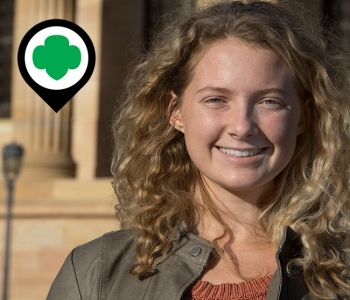Meet Katie Rose D: She Puts the Leader in G.I.R.L.

The young women featured in this series have not only earned Girl Scouts’ highest honor by being named 2016 National Young Women of Distinction—they also serve as incredible examples of what it means to be a G.I.R.L. (Go-getter, Innovator, Risk-taker, Leader)™.
I’m from Georgia, and I go to a school where I used to think most of the kids were pretty well-off, or at least from families that were doing okay financially. Which is why one day, when the cafeteria ladies put a bunch of extra food out at the end of the week, I was surprised to see a friend of mine from class take six or seven of the sandwiches.
I kind of joked with her and asked if she was really hungry that day or something, but her answer really shocked me. She said she was taking so much food to make sure that she and her brother would have something to eat over the weekend. This was a girl who’d sat right next to me in our language arts class. We’d done a lot of class projects together and I thought I knew her really well. Hearing that she was struggling at home to have a meal on the table was really hard for me to understand. How could that be?
I started looking into the issue of hunger across the country, and I discovered that it’s a really big problem. One in four children in the U.S. fit the definition of “food insecure,” meaning they don’t know where their next meal will come from—and the number in my area is even higher. It turns out that in my community, 60 percent of the students receive free or reduced-fee cafeteria meals. That’s three out of five kids!
Girl Scouts had always taught me that when I see a problem, I should try to take action and actually do something to fix it, so I started thinking about what I could do to help my friend and other kids in similar situations. There had to be enough food to go around. So for my Gold Award project, I started a program called Sow More, Grow More, asking farmers, gardeners, and regular community members to donate their extra fruits and vegetables to the local food bank—especially during the summer months when kids wouldn’t have access to school cafeteria food.
Hunger is still a big problem in Georgia and across our whole country, but I’m happy to know that my efforts—and those of everyone who’s pitched in on the project—are making a difference. Over the first two summers alone, we generated more than 1,400 pounds of fresh food and have served more than 2,200 families. More than that, I specifically designed the program so that it can be easily replicated in other communities where hunger is a prominent issue.





